Vehicle specifications HYUNDAI I30 2023 Owners Manual
[x] Cancel search | Manufacturer: HYUNDAI, Model Year: 2023, Model line: I30, Model: HYUNDAI I30 2023Pages: 533, PDF Size: 59.13 MB
Page 4 of 533

F4
FOREWORD
Thank you for choosing HYUNDAI. We are pleased to welcome you to the growing number of discerning people who
drive HYUNDAIs. The advanced engineering and high-quality construction of each HYUNDAI we build is something of
which we're very proud.
Your Owner's Manual will introduce you to the features and operation of your new HYUNDAI. It is suggested that you read
it carefully because the information it contains can contribute greatly to the satisfaction you receive from your new vehi-
cle.
The manufacturer also recommends that service and maintenance on your vehicle be performed by an authorised
HYUNDAI dealer.
HYUNDAI MOTOR COMPANY
Note :Because future owners will also need the information included in this manual, if you sell this HYUNDAI, please
leave the manual in the vehicle for their use. Thank you.
Copyright 2019 HYUNDAI Motor Company. All rights reserved. No part of this publication may be reproduced, stored
in any retrieval system or transmitted in any form or by any means without the prior written permission of HYUNDAI
Motor Company.Severe engine and transmission damage may result from the use of poor quality fuels and lubricants that
do not meet HYUNDAI specifications. You must always use high quality fuels and lubricants that meet the
specifications listed on Page 8-7 in the Vehicle Specifications section of this Owner's Manual.
CAUTION
Page 10 of 533

F10
Introduction
Diesel engine
Diesel fuel
Diesel engines must be operated
only on commercially available diesel
fuel that complies with EN 590 or
comparable standard. (EN stands for
"European Norm"). Do not use
marine diesel fuel, heating oils, or
non-approved fuel additives, as this
will increase wear and cause dam-
age to the engine and fuel system.
The new vehicle warranty may be
invalidated if non-approved fuels
and/or fuel additives are used.
Diesel fuel of above cetane 51
should be used in your vehicle. If two
types of diesel fuel are available, use
summer or winter fuel properly
according to the following tempera-
ture conditions.
Above -5°C (23°F) ... Summer type
diesel fuel.
Below -5°C (23°F) ... Winter type
diesel fuel.
Watch the fuel level in the tank very
carefully : If the engine stops through
fuel failure, the circuits must be com-
pletely purged to permit restarting.Do not let any petrol or water enter
the tank. This would make it nec-
essary to drain it out and to bleed
the lines to avoid jamming the
injection pump and damaging the
engine.
It is recommended to use the reg-
ulated automotive diesel fuel for
diesel vehicle equipped with the
DPF system.
If you use diesel fuel including
high sulfur (more than 50 ppm sul-
fur) and unspecified additives, it
can cause the DPF system to be
damaged and white smoke can be
emitted.
Biodiesel
Commercially supplied Diesel blends
of no more than 7% biodiesel, com-
monly known as "B7 Diesel" may be
used in your vehicle if Biodiesel meets
EN 14214 or equivalent specifications.
(EN stands for "European Norm"). The
use of biofuels exceeding 7% made
from rapeseed methyl ester (RME),
fatty acid methyl ester (FAME), veg-
etable oil methyl ester (VME) etc. or
mixing diesel exceeding 7% with
biodiesel will cause increased wear or
damage to the engine and fuel sys-
tem. Repair or replacement of worn or
damaged components due to the use
of non approved fuels will not be cov-
ered by the manufacturer's warranty.
Never use any fuel, whether
diesel, B7 biodiesel or other-
wise, that fails to meet the latest
petroleum industry specifica-
tion.
Never use any fuel additives or
treatments that are not recom-
mended or approved by the
vehicle manufacturer.
NOTICE
NOTICE
NOTICE
Page 13 of 533

1
2
3
4
5
6
7
8
I
Your vehicle at a glance
Safety system of your vehicle
Convenient features of your vehicle
Multimedia System
Driving your vehicle
What to do in an emergency
Maintenance
Specifications & Consumer information
Index
TABLE OF CONTENTS
Page 406 of 533

5-141
Driving your vehicle
5
Two labels on your driver’s door sill
show how much weight your vehicle
was designed to carry: the Tyre and
Loading Information Label and the
Certification Label.
Before loading your vehicle, famil-
iarise yourself with the following
terms for determining your vehicle's
weight ratings, from the vehicle's
specifications and the Certification
Label:
Base Kerb Weight
This is the weight of the vehicle includ-
ing a full tank of fuel and all standard
equipment. It does not include pas-
sengers, cargo, or optional equipment.
Vehicle Kerb Weight
This is the weight of your new vehicle
when you picked it up from your deal-
er plus any aftermarket equipment.
Cargo Weight
This figure includes all weight added
to the Base Kerb Weight, including
cargo and optional equipment.GAW (Gross Axle Weight)
This is the total weight placed on
each axle (front and rear) - including
vehicle kerb weight and all payload.
GAWR (Gross Axle Weight Rating)
This is the maximum allowable
weight that can be carried by a single
axle (front or rear). These numbers
are shown on the Certification Label.
The total load on each axle must
never exceed its GAWR.
GVW (Gross Vehicle Weight)
This is the Base Kerb Weight plus
actual Cargo Weight plus passen-
gers.
GVWR (Gross Vehicle Weight
Rating)
This is the maximum allowable
weight of the fully loaded vehicle
(including all options, equipment,
passengers and cargo). The GVWR
is shown on the Certification Label
located on the driver’s door sill.Overloading
V VE
EH
HI
IC
CL
LE
E
W
WE
EI
IG
GH
HT
T
The Gross Axle Weight Rating
(GAWR) and the Gross Vehicle
Weight Rating (GVWR) for your
vehicle are on the Certification
Label attached to the driver's
(or front passenger’s) door.
Exceeding these ratings can
cause an accident or vehicle
damage. You can calculate the
weight of your load by weighing
the items (and people) before
putting them in the vehicle. Be
careful not to overload your
vehicle.
WARNING
Page 478 of 533
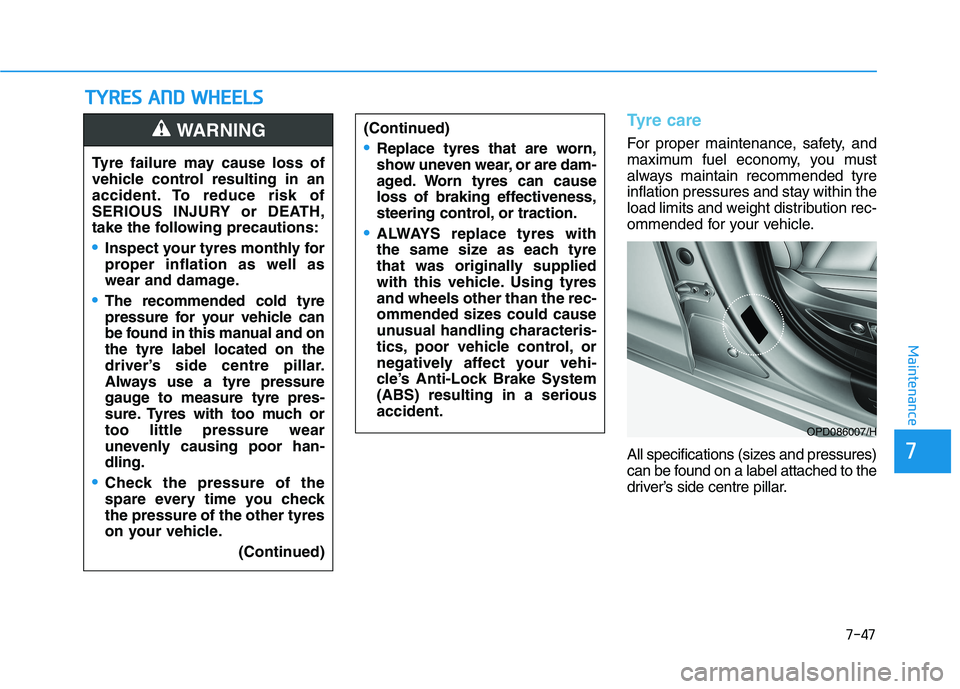
7-47
7
Maintenance
T TY
YR
RE
ES
S
A
AN
ND
D
W
WH
HE
EE
EL
LS
S
Tyre care
For proper maintenance, safety, and
maximum fuel economy, you must
always maintain recommended tyre
inflation pressures and stay within the
load limits and weight distribution rec-
ommended for your vehicle.
All specifications (sizes and pressures)
can be found on a label attached to the
driver’s side centre pillar. (Continued)Replace tyres that are worn,
show uneven wear, or are dam-
aged. Worn tyres can cause
loss of braking effectiveness,
steering control, or traction.
ALWAYS replace tyres with
the same size as each tyre
that was originally supplied
with this vehicle. Using tyres
and wheels other than the rec-
ommended sizes could cause
unusual handling characteris-
tics, poor vehicle control, or
negatively affect your vehi-
cle’s Anti-Lock Brake System
(ABS) resulting in a serious
accident.
Tyre failure may cause loss of
vehicle control resulting in an
accident. To reduce risk of
SERIOUS INJURY or DEATH,
take the following precautions:
Inspect your tyres monthly for
proper inflation as well as
wear and damage.
The recommended cold tyre
pressure for your vehicle can
be found in this manual and on
the tyre label located on the
driver’s side centre pillar.
Always use a tyre pressure
gauge to measure tyre pres-
sure. Tyres with too much or
too little pressure wear
unevenly causing poor han-
dling.
Check the pressure of the
spare every time you check
the pressure of the other tyres
on your vehicle.
(Continued)
WARNING
OPD086007/H
Page 522 of 533
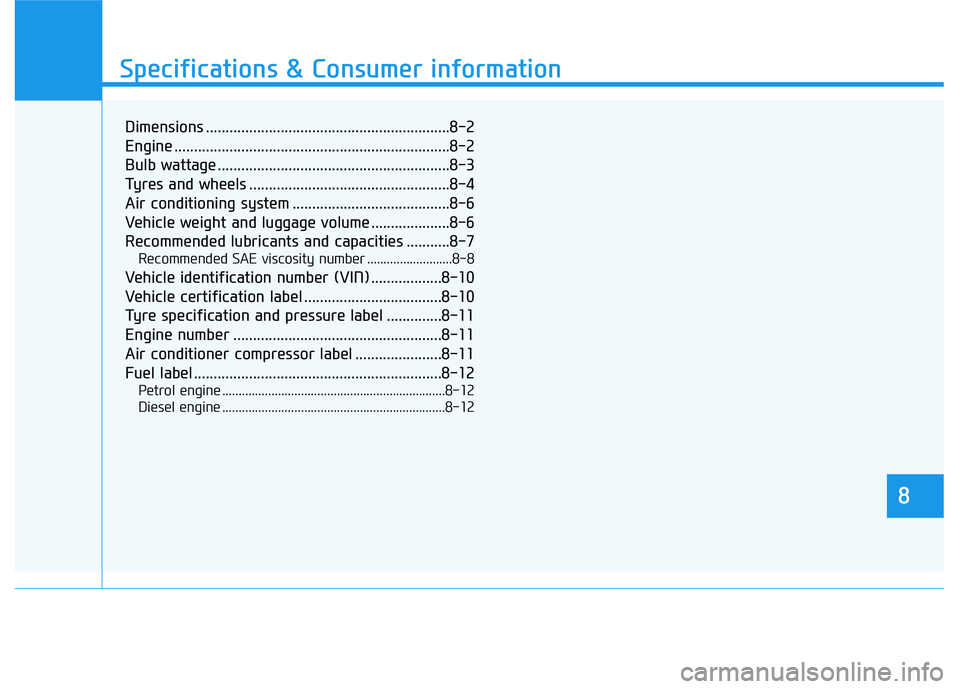
8
Specifications & Consumer information
8
Specifications & Consumer information
8
Dimensions ..............................................................8-2
Engine ......................................................................8-2
Bulb wattage ...........................................................8-3
Tyres and wheels ...................................................8-4
Air conditioning system ........................................8-6
Vehicle weight and luggage volume ....................8-6
Recommended lubricants and capacities ...........8-7
Recommended SAE viscosity number ..........................8-8
Vehicle identification number (VIN) ..................8-10
Vehicle certification label ...................................8-10
Tyre specification and pressure label ..............8-11
Engine number .....................................................8-11
Air conditioner compressor label ......................8-11
Fuel label ...............................................................8-12
Petrol engine ....................................................................8-12
Diesel engine ....................................................................8-12
Page 526 of 533
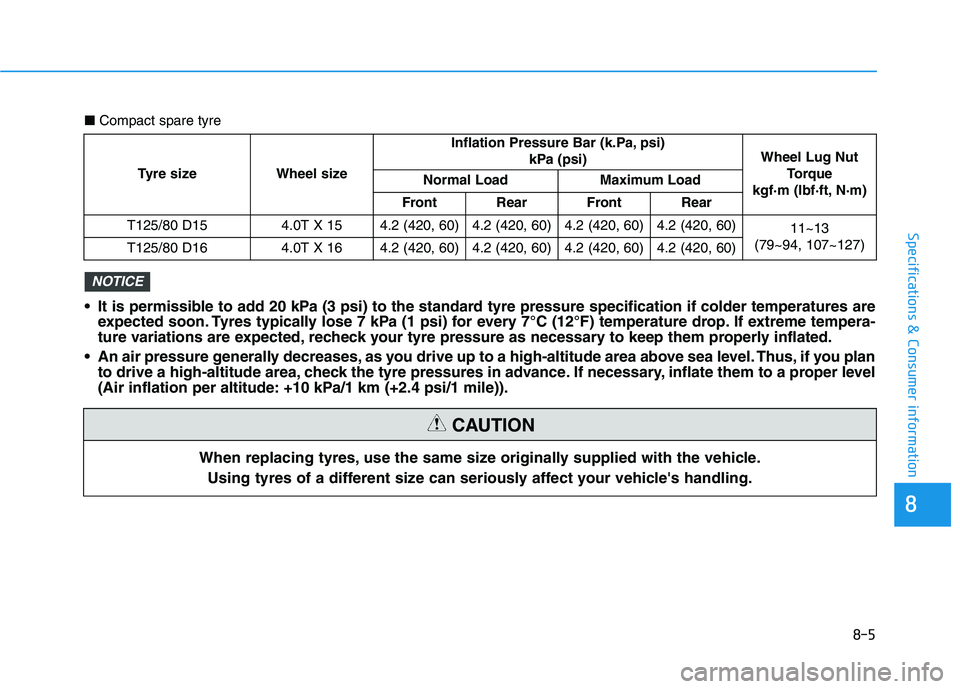
8-5
8
Specifications & Consumer information
When replacing tyres, use the same size originally supplied with the vehicle.
Using tyres of a different size can seriously affect your vehicle's handling.
CAUTION
It is permissible to add 20 kPa (3 psi) to the standard tyre pressure specification if colder temperatures are
expected soon. Tyres typically lose 7 kPa (1 psi) for every 7°C (12°F) temperature drop. If extreme tempera-
ture variations are expected, recheck your tyre pressure as necessary to keep them properly inflated.
An air pressure generally decreases, as you drive up to a high-altitude area above sea level. Thus, if you plan
to drive a high-altitude area, check the tyre pressures in advance. If necessary, inflate them to a proper level
(Air inflation per altitude: +10 kPa/1 km (+2.4 psi/1 mile)).
NOTICE
■Compact spare tyre
Tyre size Wheel sizeInflation Pressure Bar (k.Pa, psi)
kPa (psi)Wheel Lug Nut
Torque
kgf·m (lbf·ft, N·m) Normal Load Maximum Load
Front Rear Front Rear
T125/80 D15 4.0T X 15 4.2 (420, 60) 4.2 (420, 60) 4.2 (420, 60) 4.2 (420, 60)
11~13
(79~94, 107~127)
T125/80 D16 4.0T X 16 4.2 (420, 60) 4.2 (420, 60) 4.2 (420, 60) 4.2 (420, 60)
Page 527 of 533

8-6
Specifications & Consumer information
A AI
IR
R
C
CO
ON
ND
DI
IT
TI
IO
ON
NI
IN
NG
G
S
SY
YS
ST
TE
EM
M
ItemPetrol Engine Diesel Engine
1.6 T-GDI 2.0 GDI 1.6 TCI
M/T DCT M/T A/T M/T DCT
Gross vehicle weight
kg (lbs.)1,850
(4,078)1,880
(4,144)1,820
(4,012)1,850
(4,078)1,880
(4,144)1,900
(4,188)
Luggage volume (VDA)
l(cu ft.)MIN 395 (13.95)
MAX 1,301 (45.94)
V VE
EH
HI
IC
CL
LE
E
W
WE
EI
IG
GH
HT
T
A
AN
ND
D
L
LU
UG
GG
GA
AG
GE
E
V
VO
OL
LU
UM
ME
E
ItemsWeight of Volume Classification
Refrigerant g (oz.)500 (17.63)R-134a
Compressor lubricant g (oz.)110±10 (3.88±0.35)PA G
Contact an authorised HYUNDAI dealer for more details.
M/T : Manual transmission
A/T : Automatic transmission
DCT : Dual clutch transmission
Min : Behind rear seat to upper edge of the seat back.
Max : Behind front seat to roof.
Page 528 of 533
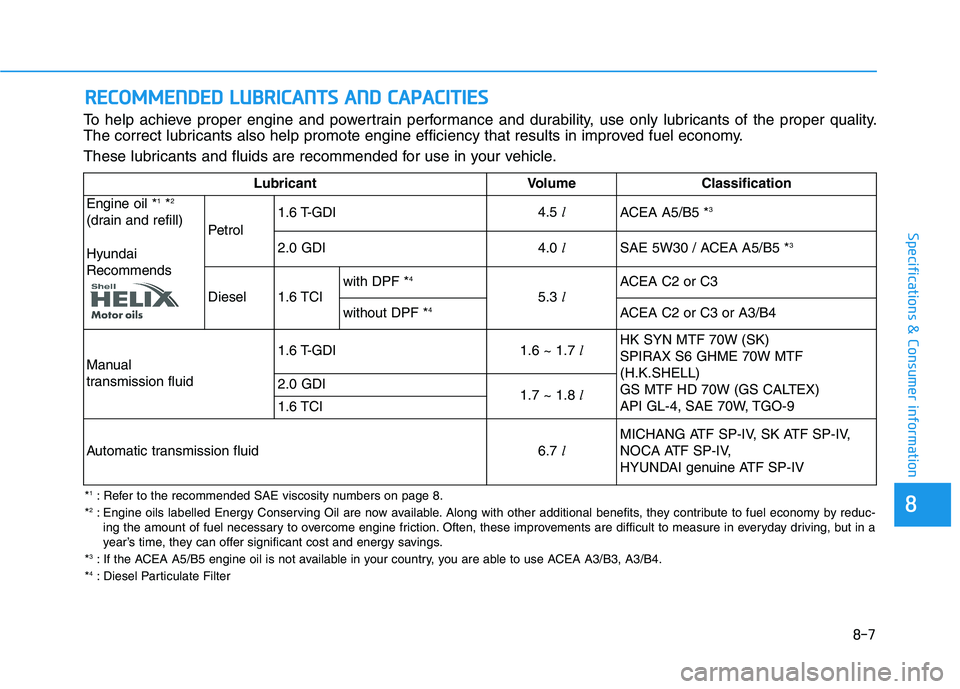
8-7
Specifications & Consumer information
R RE
EC
CO
OM
MM
ME
EN
ND
DE
ED
D
L
LU
UB
BR
RI
IC
CA
AN
NT
TS
S
A
AN
ND
D
C
CA
AP
PA
AC
CI
IT
TI
IE
ES
S
To help achieve proper engine and powertrain performance and durability, use only lubricants of the proper quality.
The correct lubricants also help promote engine efficiency that results in improved fuel economy.
These lubricants and fluids are recommended for use in your vehicle.
Lubricant Volume Classification
Engine oil *
1*2
(drain and refill)
Hyundai
RecommendsPetrol1.6 T-GDI4.5 l
ACEA A5/B5 *3
2.0 GDI4.0 l
SAE 5W30 / ACEA A5/B5 *3
Diesel 1.6 TCIwith DPF *
4
5.3 lACEA C2 or C3
without DPF *4ACEA C2 or C3 or A3/B4
Manual
transmission fluid1.6 T-GDI1.6 ~ 1.7 lHK SYN MTF 70W (SK)
SPIRAX S6 GHME 70W MTF
(H.K.SHELL)
GS MTF HD 70W (GS CALTEX)
API GL-4, SAE 70W, TGO-9 2.0 GDI
1.7 ~ 1.8 l
1.6 TCI
Automatic transmission fluid6.7 lMICHANG ATF SP-IV, SK ATF SP-IV,
NOCA ATF SP-IV,
HYUNDAI genuine ATF SP-IV
8*1: Refer to the recommended SAE viscosity numbers on page 8.
*2: Engine oils labelled Energy Conserving Oil are now available. Along with other additional benefits, they contribute to fuel economy by reduc-
ing the amount of fuel necessary to overcome engine friction. Often, these improvements are difficult to measure in everyday driving, but in a
year’s time, they can offer significant cost and energy savings.
*
3: If the ACEA A5/B5 engine oil is not available in your country, you are able to use ACEA A3/B3, A3/B4.
*4: Diesel Particulate Filter
Page 529 of 533
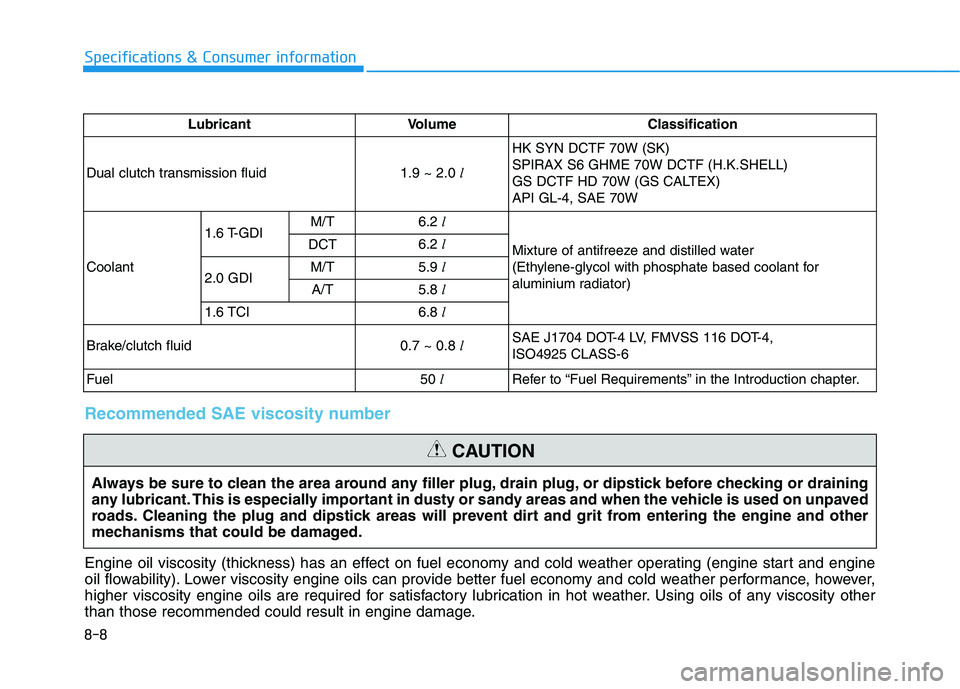
8-8
Specifications & Consumer information
Lubricant Volume Classification
Dual clutch transmission fluid1.9 ~ 2.0 lHK SYN DCTF 70W (SK)
SPIRAX S6 GHME 70W DCTF (H.K.SHELL)
GS DCTF HD 70W (GS CALTEX)
API GL-4, SAE 70W
Coolant1.6 T-GDIM/T6.2 l
Mixture of antifreeze and distilled water
(Ethylene-glycol with phosphate based coolant for
aluminium radiator) DCT6.2 l
2.0 GDIM/T5.9 l
A/T5.8 l
1.6 TCI6.8 l
Brake/clutch fluid0.7 ~ 0.8 lSAE J1704 DOT-4 LV, FMVSS 116 DOT-4,
ISO4925 CLASS-6
Fuel50 l
Refer to “Fuel Requirements” in the Introduction chapter.
Always be sure to clean the area around any filler plug, drain plug, or dipstick before checking or draining
any lubricant. This is especially important in dusty or sandy areas and when the vehicle is used on unpaved
roads. Cleaning the plug and dipstick areas will prevent dirt and grit from entering the engine and other
mechanisms that could be damaged.
CAUTION
Recommended SAE viscosity number
Engine oil viscosity (thickness) has an effect on fuel economy and cold weather operating (engine start and engine
oil flowability). Lower viscosity engine oils can provide better fuel economy and cold weather performance, however,
higher viscosity engine oils are required for satisfactory lubrication in hot weather. Using oils of any viscosity other
than those recommended could result in engine damage.